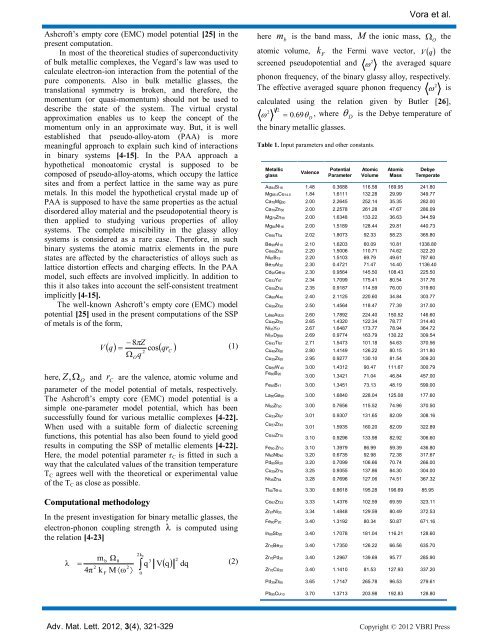Superconducting state parameters of binary metallic glasses
Superconducting state parameters of binary metallic glasses
Superconducting state parameters of binary metallic glasses
Create successful ePaper yourself
Turn your PDF publications into a flip-book with our unique Google optimized e-Paper software.
Ashcr<strong>of</strong>t’s empty core (EMC) model potential [25] in the<br />
present computation.<br />
In most <strong>of</strong> the theoretical studies <strong>of</strong> superconductivity<br />
<strong>of</strong> bulk <strong>metallic</strong> complexes, the Vegard’s law was used to<br />
calculate electron-ion interaction from the potential <strong>of</strong> the<br />
pure components. Also in bulk <strong>metallic</strong> <strong>glasses</strong>, the<br />
translational symmetry is broken, and therefore, the<br />
momentum (or quasi-momentum) should not be used to<br />
describe the <strong>state</strong> <strong>of</strong> the system. The virtual crystal<br />
approximation enables us to keep the concept <strong>of</strong> the<br />
momentum only in an approximate way. But, it is well<br />
established that pseudo-alloy-atom (PAA) is more<br />
meaningful approach to explain such kind <strong>of</strong> interactions<br />
in <strong>binary</strong> systems [4-15]. In the PAA approach a<br />
hypothetical monoatomic crystal is supposed to be<br />
composed <strong>of</strong> pseudo-alloy-atoms, which occupy the lattice<br />
sites and from a perfect lattice in the same way as pure<br />
metals. In this model the hypothetical crystal made up <strong>of</strong><br />
PAA is supposed to have the same properties as the actual<br />
disordered alloy material and the pseudopotential theory is<br />
then applied to studying various properties <strong>of</strong> alloy<br />
systems. The complete miscibility in the glassy alloy<br />
systems is considered as a rare case. Therefore, in such<br />
<strong>binary</strong> systems the atomic matrix elements in the pure<br />
<strong>state</strong>s are affected by the characteristics <strong>of</strong> alloys such as<br />
lattice distortion effects and charging effects. In the PAA<br />
model, such effects are involved implicitly. In addition to<br />
this it also takes into account the self-consistent treatment<br />
implicitly [4-15].<br />
The well-known Ashcr<strong>of</strong>t’s empty core (EMC) model<br />
potential [25] used in the present computations <strong>of</strong> the SSP<br />
<strong>of</strong> metals is <strong>of</strong> the form,<br />
here, Z, O<br />
and C<br />
8 Z<br />
V q cosqrC<br />
<br />
(1)<br />
2<br />
q<br />
O<br />
r are the valence, atomic volume and<br />
parameter <strong>of</strong> the model potential <strong>of</strong> metals, respectively.<br />
The Ashcr<strong>of</strong>t’s empty core (EMC) model potential is a<br />
simple one-parameter model potential, which has been<br />
successfully found for various <strong>metallic</strong> complexes [4-22].<br />
When used with a suitable form <strong>of</strong> dialectic screening<br />
functions, this potential has also been found to yield good<br />
results in computing the SSP <strong>of</strong> <strong>metallic</strong> elements [4-22].<br />
Here, the model potential parameter rC is fitted in such a<br />
way that the calculated values <strong>of</strong> the transition temperature<br />
TC agrees well with the theoretical or experimental value<br />
<strong>of</strong> the TC as close as possible.<br />
Computational methodology<br />
In the present investigation for <strong>binary</strong> <strong>metallic</strong> <strong>glasses</strong>, the<br />
electron-phonon coupling strength λ is computed using<br />
the relation [4-23]<br />
λ<br />
2k<br />
F<br />
m b Ω0<br />
3 2<br />
q Vq<br />
dq (2)<br />
2<br />
2<br />
4π k M ω<br />
<br />
F<br />
0<br />
Vora et al.<br />
here b m is the band mass, M the ionic mass, the O<br />
atomic volume, F<br />
screened pseudopotential and<br />
k the Fermi wave vector, q V the<br />
2<br />
the averaged square<br />
phonon frequency, <strong>of</strong> the <strong>binary</strong> glassy alloy, respectively.<br />
The effective averaged square phonon frequency<br />
2<br />
is<br />
calculated using the relation given by Butler [26],<br />
2<br />
<br />
1 2<br />
0.<br />
69<br />
is the Debye temperature <strong>of</strong><br />
, where D<br />
D<br />
the <strong>binary</strong> <strong>metallic</strong> <strong>glasses</strong>.<br />
Table 1. Input <strong>parameters</strong> and other constants.<br />
Adv. Mat. Lett. 2012, 3(4), 321-329 Copyright © 2012 VBRI Press<br />
Metallic<br />
glass<br />
Valence<br />
Potential<br />
Parameter<br />
Atomic<br />
Volume<br />
Atomic<br />
Mass<br />
Debye<br />
Temperate<br />
Au84Si16 1.48 0.3688 116.58 169.95 241.80<br />
Mg85.5Cu14.5 1.84 1.6111 132.28 29.99 349.77<br />
Ca70Mg30 2.00 2.2645 252.14 35.35 282.00<br />
Ca70Zn30 2.00 2.2578 261.28 47.67 286.09<br />
Mg70Zn30 2.00 1.6348 133.22 36.63 344.59<br />
Mg84Ni16 2.00 1.5189 128.44 29.81 440.73<br />
Cu66Ti34 2.02 1.8073 92.33 58.23 365.80<br />
Be90Al10 2.10 1.6203 60.09 10.81 1338.80<br />
Cu60Zr40 2.20 1.5006 110.71 74.62 322.20<br />
Ni81B19 2.20 1.5103 69.79 49.61 787.60<br />
Be70Al30 2.30 0.4721 71.47 14.40 1136.40<br />
Cd90Ge10 2.30 0.9564 145.50 108.43 225.50<br />
Cu33Y67 2.34 1.7099 175.41 80.54 317.76<br />
Cu55Zr45 2.35 0.9187 114.59 76.00 319.60<br />
Ca60Al40 2.40 2.1125 220.60 34.84 303.77<br />
Cu50Zr50 2.50 1.4564 118.47 77.39 317.00<br />
La80Au20 2.60 1.7892 224.40 150.52 146.60<br />
Cu45Zr55 2.65 1.4320 122.34 78.77 314.40<br />
Ni33Y67 2.67 1.6487 173.77 78.94 364.72<br />
Ni31Dy69 2.69 0.9774 163.79 130.22 309.54<br />
Cu43Ti57 2.71 1.5473 101.18 54.63 370.56<br />
Cu40Zr60 2.80 1.4149 126.22 80.15 311.80<br />
Cu35Zr65 2.95 0.9277 130.10 81.54 309.20<br />
Cu60W 40 3.00 1.4312 90.47 111.67 300.79<br />
Fe80B20<br />
3.00 1.3421 71.04 46.84 457.00<br />
Fe83B17 3.00 1.3451 73.13 48.19 599.00<br />
La80Ga20 3.00 1.6840 228.04 125.08 177.60<br />
Ni50Zr50 3.00 0.7656 115.52 74.96 370.50<br />
Cu33Zr67 3.01 0.9307 131.65 82.09 308.16<br />
Cu57Zr43<br />
Cu30Zr70<br />
3.01 1.5935 160.20 82.09 322.89<br />
3.10 0.9296 133.98 82.92 306.60<br />
Fe90 Zr10 3.10 1.3979 86.99 59.39 436.80<br />
Ni60Nb40 3.20 0.6735 92.98 72.38 317.67<br />
Pd80Si20 3.20 0.7099 106.66 70.74 266.00<br />
Cu25Zr75 3.25 0.9355 137.86 84.30 304.00<br />
Ni36Zr64 3.28 0.7696 127.06 74.51 367.32<br />
Tl90Te10 3.30 0.8618 195.28 196.69 85.95<br />
Co67Zr33 3.33 1.4376 102.59 69.59 323.11<br />
Zr67Ni33 3.34 1.4848 129.59 80.49 372.53<br />
Fe80P20 3.40 1.3192 80.34 50.87 671.16<br />
In80Sb20 3.40 1.7078 181.04 116.21 128.60<br />
Zr70Be30 3.40 1.7350 126.22 66.56 635.70<br />
Zr70Pd30 3.40 1.2967 139.69 95.77 285.90<br />
Zr70Co30 3.40 1.1410 81.53 127.93 337.20<br />
Pd35Zr65 3.65 1.7147 265.78 96.53 279.61<br />
Pb90Cu10 3.70 1.3713 203.98 192.83 128.80
















